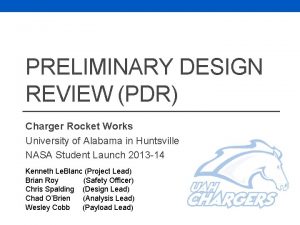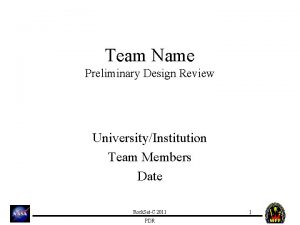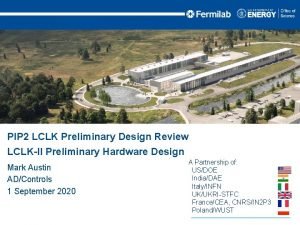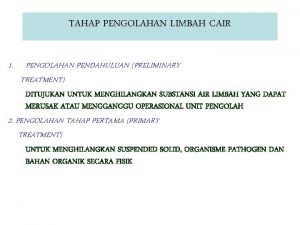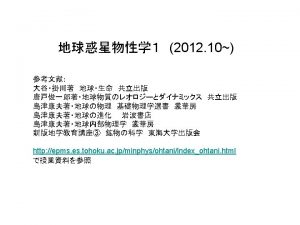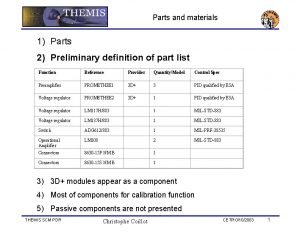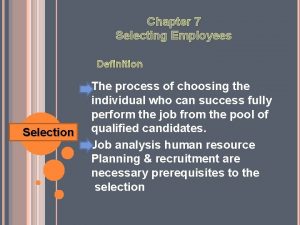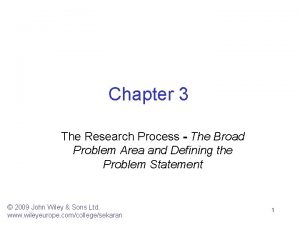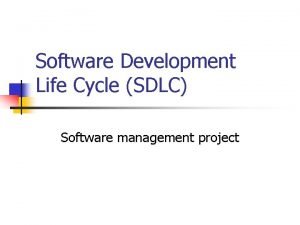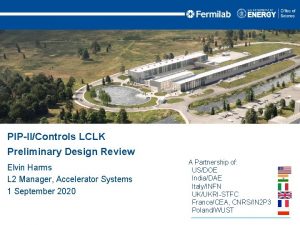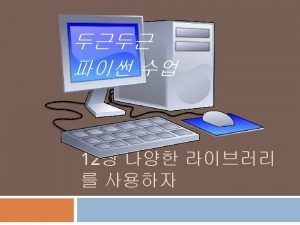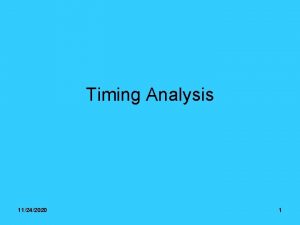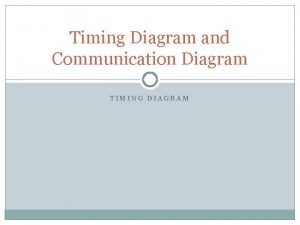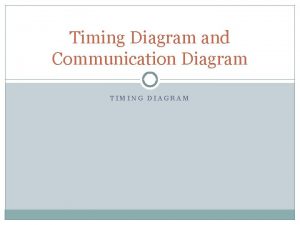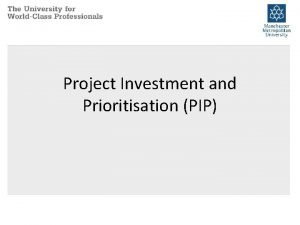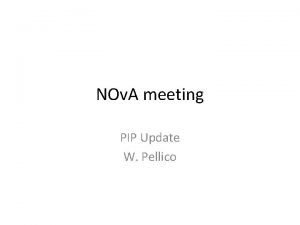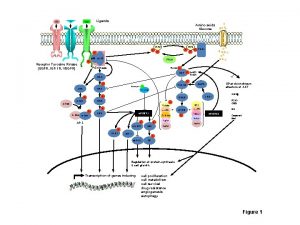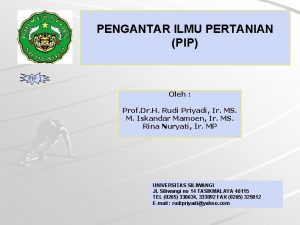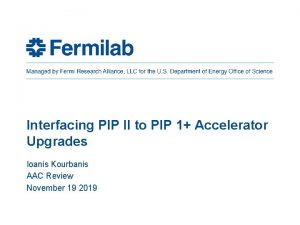PIP 2 LCLK Preliminary Design Review Timing System


















- Slides: 18

PIP 2 LCLK Preliminary Design Review Timing System Introduction Gregory Vogel AD/Controls 1 September 2020 A Partnership of: US/DOE India/DAE Italy/INFN UK/UKRI-STFC France/CEA, CNRS/IN 2 P 3 Poland/WUST

PIP-II Timing System • Introduction • The PIP-II Linac will be part of a larger accelerator complex involving 4 synchrotrons and associated beamlines supplying particle beams to high and low energy neutrino experimental areas (LBNF, LAr. TF & SBN), muon experimental areas (g-2 & Mu 2 e) and the experimental test areas fed via Fermilab’s Switchyard (Mtest, Mcenter & Spin. Quest). It will be the task of the PIP-II Timing System to coordinate the operation of both the Linac and the rest of the accelerator complex by the distribution of the required clocks, machine resets, triggers and system state information. – The repetition rate of the Linac beam pulse (macro pulse) will be 20 Hz. – The macro pulse request (Booster Beam Resets) must be synchronized to the 60 Hz Booster mains frequency. – The timing system will distribute timing system information (via ACLK, TCLK or LCLK-II) to all relevant machine locations. – This review is of the LCLK-II subsection of the PIP-II Timing System. 2 9/1/20 PIP 2 LCLK | PDR

PIP-II Timing System Block Diagram 3 9/1/20 PIP 2 LCLK | PDR

PIP-II LINAC Timing System • • 4 The PIP-II timing system is planned to be a two part system. The first part is a global timing system (here called ACLK) that provides high level, event based timing for the whole Fermilab accelerator complex while the second part is a RF synchronized clock system unique to the PIP-II linac itself (here called LCLK-II). This two level clock system concept has been used at Fermilab (TCLK & individual machine Beam Sync Clocks) to support complex operations for over 20 years through both the Tevatron and Neutrino operational eras. This concept provided significant operational flexibility that allowed for the successful completion of both the Tevatron Collider and Minos Experimental runs, with both programs operating in parallel. The two systems are planned to have similar hardware, with the LCLK-II generator hardware being a simplified version of the ACLK system. This is due to the LCLK Generator not requiring an interface with a Timeline Generator (TLG) to configure operational scenarios for the entire accelerator complex. It also does not require interfaces with other machine Beam Synchronous clocks, other machine Beam Permit Systems, Booster Reset timing signals, GPS receivers and various line locked inputs from a Master Clock Oscillator (MCO). It will also only be generating approximately 30 clock events versus the 200+ events required on ACLK. 9/1/20 PIP 2 LCLK | PDR

PIP-II LINAC Timing System • • • 5 The systems are planned to have common Fanout and Decoding hardware. General purpose clock decoders are expected to be designed in a PMC format comparable to the PMC-UCDs presently used for TCLK decoding by front ends around the complex and as a FPGA design that can be included in other designs. LCLK-II will use a PIP-II Linac RF reference (162. 5 MHz) from the Linac LLRF system to allow beam synchronized event placement. Appropriate TCLK/ACLK events will be decoded and reflected onto LCLK-II to support AD/Control System based data acquisition. The LCLK-II system will have a clock output with 16 bit event + 32 bit data field with frames broadcast at an upper harmonic of the 162. 5 MHz of the PIP-II LLRF (650 MHz, phase locked to the 162. 5 MHz supplied by the LLRF). The ACLK System will make use of an external 10 MHz signal source as a reference for its 650 MHz phase lock as it is the reference frequency for the TCLK output of the system (needed to support legacy hardware around complex). 9/1/20 PIP 2 LCLK | PDR

PIP-II LINAC Timing System • 6 There will be console based applications developed to provide operator interface and system configuration. – The ACLK system will have a significant software effort due to its required Timeline Generator (TLG). Preliminary design is in its early stages. – The LCLK-II system will have minimal software associated with it. It is predominately a hardware system. 9/1/20 PIP 2 LCLK | PDR

PIP-II Timing System Common Hardware • The following hardware is planned to be common between the ACLK and LCLK-II systems. It is expected that this hardware will likely be used as part of ACORN (a recently initiated Accelerator Control System upgrade project) as well. – – – 7 LCLK/ACLK Fiber Fanout Unit LCLK/ACLK Local Fanout Unit MFTU LCLK/ACLK PMC-UCD LCLK/ACLK FPGA Decoder 9/1/20 PIP 2 LCLK | PDR

LCLK-II LINAC RF Synchronous Clock System • LINAC Clock (LCLK-II) will be sourced via a single Clock Generator and transmitted on optical fiber along the length of the PIP-II Linac, to all transfer beamline device locations, to the Booster Injection area and to the AD MAC Room. • The LCLK-II source will be supplied with and decode ACLK/TCLK. Pertinent ACLK/TCLK events and their associated data fields should be reflected onto LCLK. This would negate the need for LCLK listening front ends from having to decode ACLK as a second clock required for connection to AD/Control System. • LCLK-II will use an RF reference from the PIP-II LLRF system to allow for RF synchronized event placement. All LCLK-II events will be RF synchronized. Those events requiring beam synchronization (markers, etc. ) will need to be sourced/triggered via the LLRF system. Appropriate ACLK events will be reflected onto LCLK-II to support existing accelerator control system-based data acquisition. This is similar to the existing clock system setups at FAST and PIP 2 IT. 8 9/1/20 PIP 2 LCLK | PDR

LCLK-II LINAC RF Synchronous Clock System • • 9 The LCLK-II system will have a single clock output with 16 bit event + 32 bit data field with frames broadcast at 650 MHz, synchronized with the 162. 5 MHz RF frequency received from the PIP-II LLRF. Some clock events are reflected from the accelerator clock system (ACLK/TCLK). All events on LCLK-II will be synchronized with the RF. LCLK will broadcast PIP-II LLRF sourced beam synchronous events (Macro Pulse & Bunch markers). LCLK-II will broadcast MPS sourced events (triggers, permit status, etc. , for further information see MPS PRD). LCLK-II will broadcast Rep-Rate Generator triggered events (10 Hz, 60 Hz, variable rates). LCLK-II will broadcast LEBT Chopper and Extraction Electrode Modulator triggered events. LINAC Clock (LCLK-II) will be sourced via a single Clock Generator and transmitted on optical fibers along the length of the PIP-II Linac, to all BTL device locations, to the Booster Injection area and to the Accelerator Division MAC Room for distribution to other AD/Controls systems and ACLK. 9/1/20 PIP 2 LCLK | PDR

Various LCLK-II Events • ACLK/TCLK sourced – – – $008 F – GPS locked 1 Hz event $000 F – Line Sync’d 20 Hz event $000 C – GMPS Sync’d 20 Hz event (booster resets) $0000 – Super Cycle Reset $0101 – BSSB State • PIP-II sourced – – – $0201 - HEP macro-pulse event (LLRF trigger) $0202 - Linac Pulsed Study macro-pulse event (LLRF trigger) $0203 - Linac Start of CW Study event (LLRF Trigger? ) $0204 - Linac variable bunch event (LLRF trigger) $0211 - Linac Beam Permit Fall event (MPS trigger) $0212 - Linac Beam Permit Reset event (MPS trigger) • Further events can be found in the LCLK System Technical Description 10 9/1/20 PIP 2 LCLK | PDR

LCLK-II General Requirements • • • 11 Highly reliable, fail-safe operation; Compatible with the staged PIP-II commissioning; Capable of logging and time stamping all changes of its state; Generate a Master Beam Trigger Event for the LEBT. Capable of triggering loss of MPS/beam permit events to allow post mortem fault analysis; Restricted, documented privileges to access and modify configurations; Expandable in order to support modifications and future upgrades such as new operational scenarios without major modifications; Events capable of being individually enabled/disabled; 16 bit event + 32 bit data packet (total 48 bits of data in event frame) Event data phase locked to Linac RF harmonic (162. 5 MHz) Standard encoding scheme (Modified Manchester) LCLK status output to MPS (pull Linac beam permit if RF input fails, etc. ) 9/1/20 PIP 2 LCLK | PDR

LCLK-II Input Sources • ACLK/TCLK – TCLK (prototype system input) – ACLK (final system input) • PIP-II LLRF – – – • Linac RF harmonic (162. 5 MHz) HEP macro-pulse event trigger Linac Pulsed Study macro-pulse event trigger Linac Start of CW Study event trigger Linac bunch trigger PIP-II MPS – Linac Beam Permit Fall – Linac Beam Permit Reset 12 9/1/20 PIP 2 LCLK | PDR

LCLK-II Input Sources - continued • PIP-II LEBT Chopper Modulator – Chopper event trigger • PIP-II Extraction Electrode Modulator – Extraction Electrode event trigger • PIP-II Rep-Rate Generator – – 13 10 Hz event trigger 60 Hz event trigger Rate “M” selectable event trigger Rate “N” selectable event trigger 9/1/20 PIP 2 LCLK | PDR

LCLK-II Block Diagram 14 9/1/20 PIP 2 LCLK | PDR

LCLK-II Prototype Block Diagram 15 9/1/20 PIP 2 LCLK | PDR

LCLK-II Planned Hardware • LCLK-II Generator Unit (2) – Main (LCLK Rack) & spare/development system • LCLK-II Fiber Fanout Unit (8) – 4 in PIP-II Linac gallery, 2 at LCLK Rack, 2 others • LCLK-II Local Fanout Unit (40) – 1 unit per PIP-II controls rack location • LCLK decoders (TBD) – MFTUs (40, 1 per PIP-II controls rack location) – PMC-UCD (TBD, 1 per controls front end + ? ? ) – FPGA Design 16 9/1/20 PIP 2 LCLK | PDR

LCLK-II Cost & Basic Schedule • M&S • Labor • • • $560, 000 7120 manhours Preliminary Design Prototype Design Assemble & Test Prototype System Final Design Assemble & Test Final System FY 20 FY 21 -FY 22 FY 23 FY 25 • Note: Work on LCLK-II is interleaved with ACLK Development 17 9/1/20 PIP 2 LCLK | PDR

18 9/1/20 PIP 2 LCLK | PDR
 Lclk charts
Lclk charts Preliminary design review example
Preliminary design review example Pdr preliminary design review
Pdr preliminary design review Preliminary design review example
Preliminary design review example ñporo
ñporo Pip hardware review
Pip hardware review Pip system nyc
Pip system nyc Preliminary budget
Preliminary budget Preliminary treatment adalah
Preliminary treatment adalah Preliminary survey
Preliminary survey Preliminary reference earth model
Preliminary reference earth model Parts of preliminaries
Parts of preliminaries Mla rough draft example
Mla rough draft example Preliminary interview
Preliminary interview Broad problem examples
Broad problem examples Gayne corporation's contribution margin ratio
Gayne corporation's contribution margin ratio Fly leaf 1 sa pananaliksik
Fly leaf 1 sa pananaliksik The 3 p's graphic communication
The 3 p's graphic communication Preliminary investigation in sdlc
Preliminary investigation in sdlc

